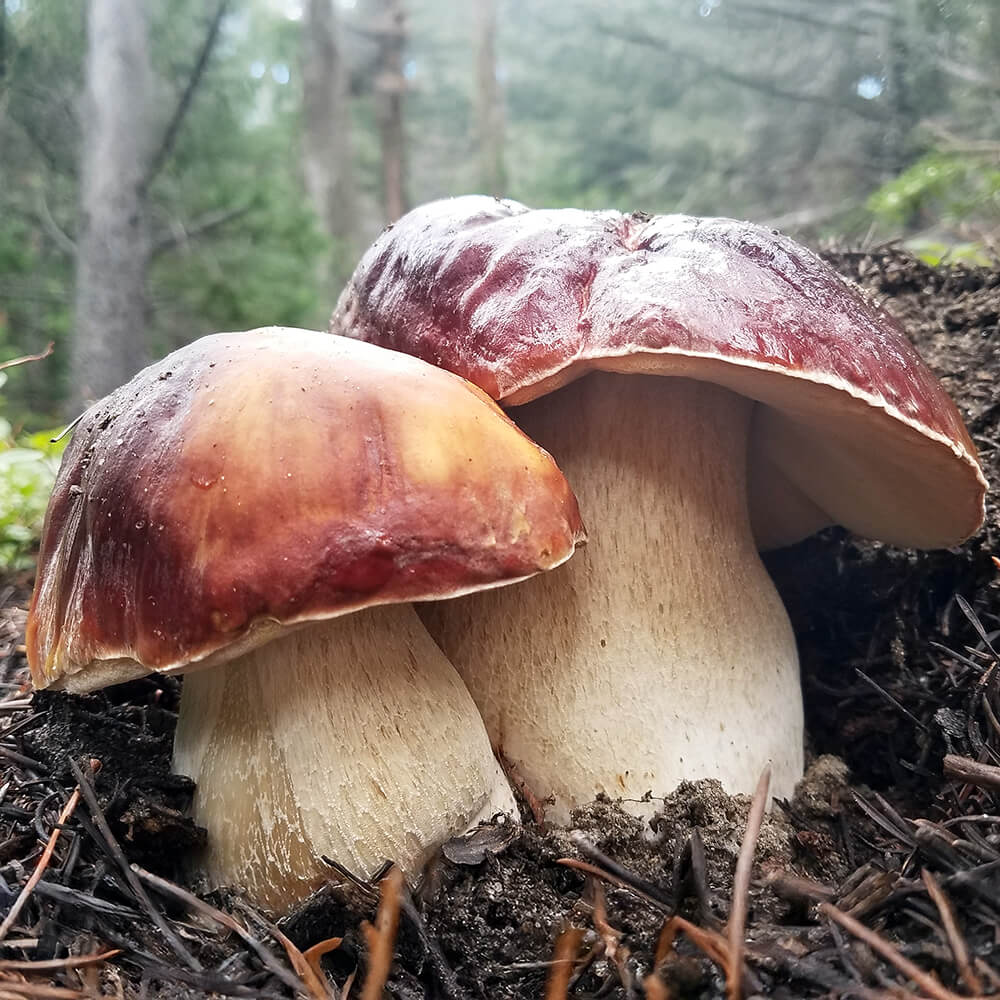Description
Ruby Porcini (Boletus rubriceps) Liquid Culture
Bullet Points:
- Premium Liquid Culture: 12cc of high-quality, nutrient-rich liquid culture for cultivating Boletus rubriceps.
- Highly Prized Edible Mushroom: A gourmet wild mushroom known for its dense texture and rich, nutty flavor.
- Sterile and Pure: Produced under sterile conditions to ensure a contamination-free culture.
- Mycorrhizal Relationship: Forms symbiotic associations with coniferous trees, making it a key part of forest ecosystems.
- User-Friendly: Ideal for mycologists, researchers, and gourmet mushroom enthusiasts interested in Boletus species.
Taxonomic Classification:
- Kingdom: Fungi
- Division: Basidiomycota
- Class: Agaricomycetes
- Order: Boletales
- Family: Boletaceae
- Genus: Boletus
- Species: Boletus rubriceps
What is the Ruby Porcini Mushroom?
The Ruby Porcini (Boletus rubriceps) is a highly sought-after wild edible mushroom, closely related to the King Bolete (Boletus edulis). It is distinguished by its deep reddish-brown cap, thick white stipe, and robust size. Found primarily in high-altitude forests, this mushroom is a favorite among foragers and gourmet chefs due to its dense texture, nutty flavor, and earthy aroma.
Like other Boletus species, the Ruby Porcini is mycorrhizal, meaning it forms mutually beneficial relationships with trees. This dependency on specific tree species makes it difficult to cultivate on traditional substrates, though liquid culture provides an opportunity for research and study.
Where Does Boletus rubriceps Grow?
Ruby Porcini is native to the Rocky Mountains of North America, thriving in high-elevation coniferous forests with pine, fir, and spruce trees. It typically fruits in late summer to early fall, especially after heavy rainfall.
Due to its strict symbiotic requirements, it is not commonly cultivated like oyster or shiitake mushrooms. However, liquid culture offers a valuable tool for researchers exploring its growth conditions, genetics, and potential for assisted cultivation.
Culinary and Medicinal Uses of Ruby Porcini
A Gourmet Mushroom with Rich Flavor
Boletus rubriceps is a prized ingredient in gourmet cuisine, valued for its meaty texture and umami depth. It is commonly used in risottos, soups, pasta dishes, and sautés. Unlike many mushrooms, it retains its firmness and flavor even after drying, making it a favorite for preservation.
Potential Health Benefits
Porcini mushrooms are rich in antioxidants, fiber, and essential minerals. Some studies suggest they have immune-boosting properties and anti-inflammatory effects, making them a nutrient-dense addition to a healthy diet.
Sustainability and Conservation of Ruby Porcini
As a wild, mycorrhizal species, Boletus rubriceps cannot be commercially cultivated in the same way as common edible mushrooms. Sustainable foraging is crucial to protecting wild populations. Conservation efforts focus on maintaining healthy forest ecosystems to ensure the continued growth of this prized species.
With this 12cc liquid culture syringe, researchers and mycologists can explore the symbiotic nature, mycelial growth, and ecological role of Boletus rubriceps in a controlled study environment.
Order Your Ruby Porcini Liquid Culture Today
Perfect for fungal researchers, gourmet foragers, and mycology enthusiasts, this premium liquid culture syringe of Boletus rubriceps provides a unique opportunity to study one of North America’s most coveted wild mushrooms.
Description
Ruby Porcini (Boletus rubriceps) Liquid Culture
Bullet Points:
- Premium Liquid Culture: 12cc of high-quality, nutrient-rich liquid culture for cultivating Boletus rubriceps.
- Highly Prized Edible Mushroom: A gourmet wild mushroom known for its dense texture and rich, nutty flavor.
- Sterile and Pure: Produced under sterile conditions to ensure a contamination-free culture.
- Mycorrhizal Relationship: Forms symbiotic associations with coniferous trees, making it a key part of forest ecosystems.
- User-Friendly: Ideal for mycologists, researchers, and gourmet mushroom enthusiasts interested in Boletus species.
Taxonomic Classification:
- Kingdom: Fungi
- Division: Basidiomycota
- Class: Agaricomycetes
- Order: Boletales
- Family: Boletaceae
- Genus: Boletus
- Species: Boletus rubriceps
What is the Ruby Porcini Mushroom?
The Ruby Porcini (Boletus rubriceps) is a highly sought-after wild edible mushroom, closely related to the King Bolete (Boletus edulis). It is distinguished by its deep reddish-brown cap, thick white stipe, and robust size. Found primarily in high-altitude forests, this mushroom is a favorite among foragers and gourmet chefs due to its dense texture, nutty flavor, and earthy aroma.
Like other Boletus species, the Ruby Porcini is mycorrhizal, meaning it forms mutually beneficial relationships with trees. This dependency on specific tree species makes it difficult to cultivate on traditional substrates, though liquid culture provides an opportunity for research and study.
Where Does Boletus rubriceps Grow?
Ruby Porcini is native to the Rocky Mountains of North America, thriving in high-elevation coniferous forests with pine, fir, and spruce trees. It typically fruits in late summer to early fall, especially after heavy rainfall.
Due to its strict symbiotic requirements, it is not commonly cultivated like oyster or shiitake mushrooms. However, liquid culture offers a valuable tool for researchers exploring its growth conditions, genetics, and potential for assisted cultivation.
Culinary and Medicinal Uses of Ruby Porcini
A Gourmet Mushroom with Rich Flavor
Boletus rubriceps is a prized ingredient in gourmet cuisine, valued for its meaty texture and umami depth. It is commonly used in risottos, soups, pasta dishes, and sautés. Unlike many mushrooms, it retains its firmness and flavor even after drying, making it a favorite for preservation.
Potential Health Benefits
Porcini mushrooms are rich in antioxidants, fiber, and essential minerals. Some studies suggest they have immune-boosting properties and anti-inflammatory effects, making them a nutrient-dense addition to a healthy diet.
Sustainability and Conservation of Ruby Porcini
As a wild, mycorrhizal species, Boletus rubriceps cannot be commercially cultivated in the same way as common edible mushrooms. Sustainable foraging is crucial to protecting wild populations. Conservation efforts focus on maintaining healthy forest ecosystems to ensure the continued growth of this prized species.
With this 12cc liquid culture syringe, researchers and mycologists can explore the symbiotic nature, mycelial growth, and ecological role of Boletus rubriceps in a controlled study environment.
Order Your Ruby Porcini Liquid Culture Today
Perfect for fungal researchers, gourmet foragers, and mycology enthusiasts, this premium liquid culture syringe of Boletus rubriceps provides a unique opportunity to study one of North America’s most coveted wild mushrooms.



